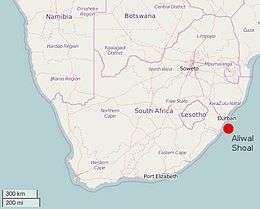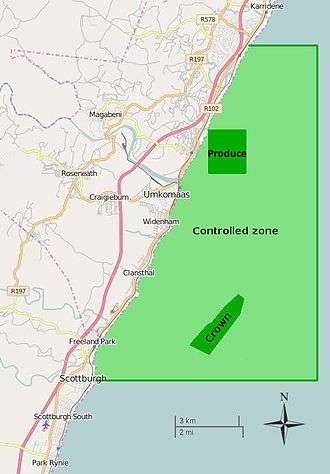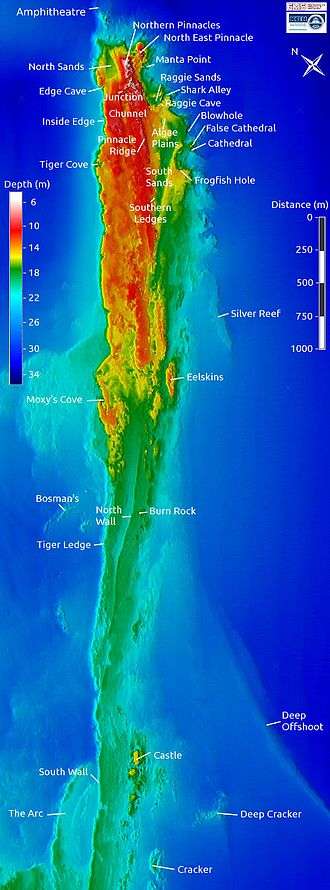Diving Aliwal Shoal
This article is intended to provide the already qualified Scuba diver with information which will help to plan dives in the waters of Aliwal Shoal, whether as a local resident or a visitor. Information is provided without prejudice, and is not guaranteed accurate or complete. Use it at your own risk. Detailed information on individual dive sites is provided in the sub-articles linked from the Dive sites section. The information in the site descriptions ranges from superficial to highly detailed, depending on what is known about the site.

In some instances a dive site sub-article will include several sites which are in close proximity, as much of the information will be common to them all. In other cases, usually involving wreck sites, two closely adjacent sites will each have their own sub-article.
.png)
Understand
During 1849, after a ship, the Aliwal, nearly collided with an uncharted reef, its captain reported the position of this reef that later became known as the Aliwal Shoal. It is located about 60 km south of Durban in South Africa. The closest towns are Umkomaas and Scottburgh, both of which offer extensive tourist facilities, also for scuba divers.
General Topography
The Aliwal Shoal is a fossilised sand dune lying roughly parallel to the coast, about 5 km from the shore. It comprises a narrow northern part (the crown, some 250 m wide, becoming about 800 m wide and finally with a wider landward ridge to the south, greater than 2 km in width. The crown varies in depth from about 6 m (around the Northern Pinnacles) to around 30 m on the seaward side. The mean depth of the crown area is 12.5 m. The southern wider area includes several protrusions that reach from a depth of some 30 m to around 15 m (e.g. Howard's Castle, Landers Reef). In the crown area, many dive sites, e.g. Raggie Cave and Chunnel have a large amount of uneven topography with small caves, ledges and swimthroughs rich in sea life, both fish-wise as well as in invertebrates, e.g. octopus.
Climate, Weather and Sea conditions
The Aliwal Shoal has a subtropical climate witch mean monthly air temperatures ranging from 17.0°C (Jul) to 23.9°C (Feb). The sea temperatures tend to be somewhat warmer, due to the warm, tropical, southward-flowing Mozambique sea current, resulting in a balmy 21-26°C throughout the year. Mean monthly weather statistics at or near the Aliwal Shoal:
The period May to July has the least wind (18 to 19 days per month less than 20 km/h, i.e. small waves with breaking crests and fairly frequent whitecaps), while September to November is more windy (10-11 days less than 20 km/h).
Depending on sea current conditions, underwater visibility is sometimes strongly affected by effluent from the Sappi-SAICCOR paper mill at Umkomaas, released through a pipe that runs some 6 km into the sea just north of the shoal, venting along a considerable length of the pipe.
The shoal often has strong currents that can be from the north or from the south. This makes for fantastic drift diving.
Marine Life

The Aliwal Shoal is a fossilised dune upon which coral and other sessile animals have established. It is therefore not a true coral reef comprising the calcareous remains of dead corals upon which other corals grow. It is a coral site surprisingly far from the equator, made possible by the warm southwards-flowing Mozambique current. Therefore it contains many of the subtropical and tropical species found further north. However, the hard corals are relatively rare compared to those on tropical reefs and soft corals are much more common. The same applies to the tropical fish encountered on the shoal: they are relative more sparse than on tropical reefs. However, a surprising variety of tropical fish are still found on the shoal, including many species of surgeonfish, goldies, rockcod, triggerfish, cardinals, scorpionfish, lionfish and representatives of most other tropical fish genera. The wreck of the MV Produce houses the endemic Harlequin goldie Pseudanthias connelli.

Aliwal shoal is well known for the ragged-tooth sharks Carcharias taurus mostly encountered during winter. They pup in the cold water of the Cape during summer. During May to August they migrate up the east coast of southern Africa and mate in the vicinity of the Durban on the KwaZulu-Natal coast, including the Aliwal Shoal. After mating they spend a few months along the subtropical coast of Mozambique before returning to the Cape in the early summer. They prefer to rest in holes, caves or depressions large enough to contain sharks. They frequently swim slowly in a semi-sleep condition and can bump against divers.
The shoal commonly hosts blacktip reef sharks Carcharhinus melanopterus, bull sharks Carcharhinus leucas and tiger sharks Galeocerdo cuvier, the latter often found at deeper depths. Blacktip reef sharks are the most commonly encountered animals during baited dives.
The shoal has large numbers of invertebrate species such as sponges, coral (mostly soft corals), molluscs such as octopus, cowries and nudibranchs, crustaceans such as shrimps and lobsters, as well as sea anemones.
The Marine Ecology
At more than 30 degrees south, the Aliwal Shoal lies at the extreme latitude at which tropical corals have been observed worldwide. The biodiversity on the shoal is shaped mainly by the amount of light that penetrates the sea water and by the physical wave action.
The shallow, northern part of the shoal with depth 6-10 m, is dominated by hard corals and sponges. Since hard corals are generally dependent on plant cells within the coral body (zooxanthellae), they are critically dependent on light for the photosynthetic products produced by the zooxanthellae. The most common hard coral species at Aliwal Shoal are the knob-horned and smooth-horned corals (Pocillopora sp. and Stylophora pistillata, repectively). The hard corals define a distinct community of animals along the top of the crown, found at dive sites such as the Northern Pinnacles and Pinnacle Ridge. The encrusting sponge Subites kelleri is also common in this area. The corals and sponges on these parts of the reef are physically robust and can withstand the wave action in shallow water.
A second distinct community on the shoal is characterised by specific soft corals, e.g. the Dead Man's Fingers (Eleutherobia aurea). These corals do not have zooxanthellae, are mostly dependent on water movement for feeding on small free-floating organisms, and cannot survive where the wave action is very strong. This community also has many sea worms (Polychaeta) and is found along the seaward as well as landward edges of the shoal at dive sites such as Raggie Sands, Blowhole and Inside Edge.
The third community is poor in distinctive corals an sponges, situated at greater depths, especially towards the southern end of the crown. However it still contains a large array of sea animals and it is easy to locate colourful nudibranchs. This area has a large abundance of algae and is found at dive sites such as North Wall and Burn Rock.
Conservation

Possible threats to the shoal include:
- Pollution from the Sappi-SAICCOR paper mill effluent pipeline into the sea. Although it is claimed that the effluent is non-toxic, it reduces the light penetration to the coral on the reef and therefore affects the symbiotic nature of the corals and their zooxanthellae.
- Pollution from the coast and Mkomazi River. The Mkomazi river arises in agricultural areas, the polluted runoff of which flows into the sea at Umkomaas. However, for this water to reach the shoal, a special combination of rainfall and sea currents is required and it is therefore not expected to be a frequent event. Usually this runoff is close to the shore and not far in the sea.
- Structural damage by scuba divers. It has been claimed that the large number of scuba divers on the shoal damage the coral. However no strong evidence for this has been presented.
- Fishing, affecting the numbers of fish on the shoal. Fishing line also entangles and damages corals. Within the crown area this has largely been alleviated by the proclamation of the Marine Protected Area (MPA).
Although the above threats are real, we know very little about the relative importance of each of them.
The Aliwal Shoal Marine Protected Area (MPA) was proclaimed in 2004 in terms of section 77 of the Marine Living Resources Act of 1998, managed by Ezemvelo KZN Wildlife. It extends 18 km along the coast from the mouth of the Mkomazi River at 30°11.92'S; 030°48.29'E to the mouth of the Mzimayi River at 30°20.80'S; 030°43.60'E south of Scottburgh and with a width of some 5-12 km into the sea. It comprises a control zone in which limited fishing is allowed and two restricted zones where no fishing is allowed. The Crown area restricted zone, delimited the 25 m isobath around the crown, includes about 2.5 km2. The Produce restricted zone includes the wreck of the MV Produce at around 30 m. The rest of the MPA is the control zone.
Respect
Diving is made acceptable to conservation authorities and the general public by the hands off principle. This means:
- Respect the coral and the fish on the shoal. Do not touch the coral. Mechanical damage to the coral degrades the environment. Collecting any items from the Restricted zones (containing most the dive sites) within the Marine Protected Area constitutes a crime.
- Respect the Ragged-tooth sharks when they are on the reef. Interference with these sharks may cause them to use less favourable places for resting and may affect their survival.
Connect
Several dive operators undertake scuba trips to the Shoal. The following are located at Umkomaas or Scottburgh, close to the shoal:
- Aghulas House, 30 Barrow Str, Umkomaas, ☎ +27 39 973-1640, e-mail: info@agulhashouse.com. RIB-based excursions, accommodation, nitrox, trimix, scuba training at all recreational and technical levels (RAID)
- Aliwal Dive Centre, 2 Moodie Str, Umkomaas, ☎ +27 39 973-2233, e-mail: dive@aliwalshoal.co.za. RIB-based excursions, recreational scuba training (PADI)
- 🌍 Aliwal Shoal Scuba,, 1 Roland Norris Drive, Umkomaas, ☎ +27 82 800-4668 (mobile), e-mail: info@aliwalshoalscubadiving.com. Mo-Su 7AM-5PM. RIB-based excursions, recreational and professional scuba training (PADI)
- Blue Ocean Dive Resort,, 2 Reynolds Str, Umkomaas, ☎ +27 39 973-0456, e-mail: bookings@blueoceandive.co.za. RIB-based excursions, accommodation, recreational scuba training (PADI)
- Crystal Divers South Africa, Blue Marlin Hotel, 180 Scott Street, Scottburgh, ☎ +27 62 929 8339 (mobile), e-mail: info@crystal-divers.co.za. 8 am- 6 pm. Paddle boarding, kite surfing, scuba diving and scuba training (PADI).
- ScubaXcursion,, Cutty Sark Hotel, Green Lane, Scottburgh, ☎ +27 39 976-0843, e-mail: diving@scubaxcursion.co.za. RIB-based excursions, nitrox, accommodation, recreational scuba training at all levels (SSI)
- The Shoal,, 21 Harvey Str, Umkomaas, ☎ +27 39 973-1777, e-mail: marc@theshoal.co.za. RIB-based excursions, recreational scuba training (RAID)
Get around
The Aliwal Shoal lies close to the towns of Umkomaas and Scottburgh, about 60 km south of Durban. Both towns have ample accommodation and dive facilities and can be reached either by motorcar or by train. Prior arrangements would be required to get from the train station to accommodation or to a dive facility. Most of the dive charter boats are large RIB's carrying 10 to 16 divers. A divemaster and skipper are generally the crew, though extra hands may be provided at the launch site to help launch the boat and move dive kit.
Equipment
Recreational scuba equipment is adequate for normal diving, since the deepest dive depth is unlikely to exceed 30 m. A DSMB and reel are advantageous. For the sites deeper than 25 m, the use of nitrox would allow a much longer bottom time.
Stay safe
At Umkomaas, inflatable boats (RIBs) with 10 to 16 seats are normally launched from the mouth of the Nkomazi River or in very calm conditions from the beach. Crossing the breakers into the sea requires strict adherence to safety procedures on a RIB. All gear including cameras need to be tied down or safely stowed. Parts of the boat trip may be rough.
The shoal frequently has strong currents or bad underwater visibility, necessitating divers to group closely and to perform drift dives. A DSMB and reel allows extra safety in the event that a diver becomes separated or lost or surfaces relatively far from a boat.
Do not closely approach sharks or touch them. Ragged-tooth sharks are not capable of directly killing a person because of their mouth structure. However, they can inflict serious wounds if they are startled or harassed. During the winter these sharks often swim slowly in a semi-sleeping state and they may therefore not swerve to avoid a diver. Keeping out of their way ensures safety. The larger Bull sharks and Tiger sharks are potentially lethal and should not be approached. (However, enjoy observing them!)

Dive sites
Crown area
Wrecks
Southern area
Read
- Bosman C, Uken R & Smith AM. (2005) Bathymetry of the Aliwal Shoal, South Africa. South African Journal of Science 101, 255-257.
- Peppard CRC, Davy SK & Pilling GM. (2010) The biology of coral reefs. Oxford University Press. 339pp.
- King D & Fraser V. (2014) The Reef Guide. Struik Nature, Cape Town.
- Bansemer, CS, Bennett MB. (2011) Sex- and maturity-based differences in movement and migration patterns of grey nurse shark, Carcharias taurus, along the eastern coast of Australia. Marine and Freshwater Research 62 (6), 596.
- Olbers JM, Celliers L, Schleyer MH. (April 2009). Zonation of benthic communities on the subtropical Aliwal Shoal, Durban, KwaZulu-Natal, South Africa. African Zoology 44(1), 8–23.
- South African Government Gazette 26433 , Notice No. 697 of 4 June 2004 Proclamation of Aliwal Shoal MPA.
- South African Government Gazette 36646 , Notice No. R110 of 3 February 2016 Modification of Aliwal Shoal MPA.
- Barker SM, Peddemors VM, Williamson JE. (2011). A video and photographic study of aggregation, swimming and respiratory behaviour changes in the Grey Nurse Shark (Carcharias taurus) in response to the presence of SCUBA divers. Marine and Freshwater Behaviour and Physiology 44 (2), 75.